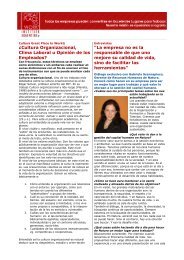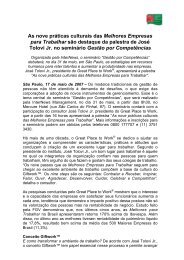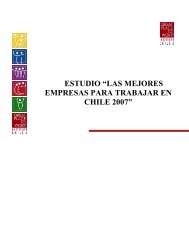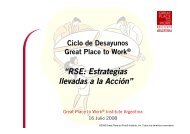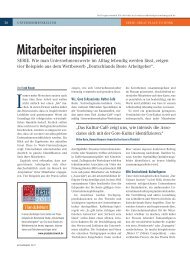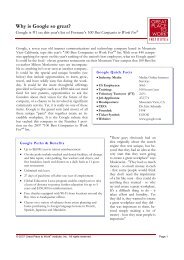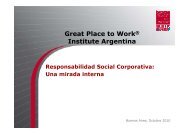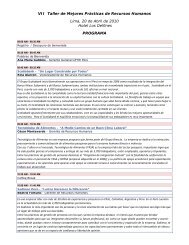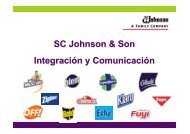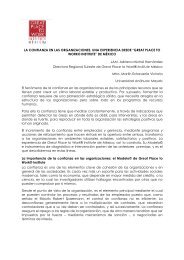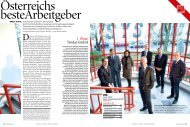Work Style - Great Place to Work Institute
Work Style - Great Place to Work Institute
Work Style - Great Place to Work Institute
You also want an ePaper? Increase the reach of your titles
YUMPU automatically turns print PDFs into web optimized ePapers that Google loves.
<strong>Great</strong> <strong>Place</strong> <strong>to</strong> <strong>Work</strong>Greece<br />
Athens<br />
www.greatplace<strong>to</strong>work.gr<br />
T 0030 2106971098<br />
Pho<strong>to</strong>grapher Friko Starc has<br />
launched global advertising<br />
strategies for brands such as<br />
American Express, Puma, Intel,<br />
and Chivas Regal for instance.<br />
Before moving <strong>to</strong> NYC in 2000,<br />
Friko taught English in a Tibetan<br />
monastery, ran a small restaurant<br />
in Goa, started a beach baseball<br />
league in Brazil, gave windsurfing<br />
lessons in Aruba, and named a<br />
couple of Unilever products in<br />
Europe.<br />
bot<strong>to</strong>m and <strong>to</strong>p employees is important <strong>to</strong> Sandra<br />
Jasmins de Freitas, Marketing and Communication<br />
Manager for Cisco Systems Portugal: “Collaboration<br />
is a key word in Cisco and it is well represented by<br />
employees’ interaction among peers and with senior<br />
management. For example, “The Breakfast Party”<br />
is where CEO John Chambers gives employees the<br />
chance <strong>to</strong> ask him questions directly.”<br />
Justin Beddows, Communications Manager for Admiral<br />
Group UK says that communication is in fact the<br />
key <strong>to</strong> this collaboration: “We have a number of ways<br />
we consult our employees for their ideas and suggestions<br />
on developing new strategies, products and services.<br />
This forms part of our general communication<br />
strategy, which is always two-ways, transparent and<br />
consultative.” Communication is stated as a primary<br />
fac<strong>to</strong>r of company success also by Nadine Hoffmann,<br />
Product Manager for DIS AG Germany: “The most important<br />
reason for our good results is the fact that<br />
we listen <strong>to</strong> the needs of our employees and that we<br />
take every one of them seriously as an individual.<br />
The people in our company feel that this is not a<br />
marketing slogan, but that we really mean it.” Marco<br />
Scippa, Human Resources for Elica Italy talks about<br />
specific examples of how people get involved: “We<br />
involve our people regulary using our House Organ<br />
(Elica News), General meeting (when we have special<br />
events), and Face <strong>to</strong> Face meeting with our CEO and<br />
President (every two months).”<br />
On this point of involving employees, Anja Buechel,<br />
Communications for Hilti Switzerland offers a unique<br />
method in how <strong>to</strong> improve this goal: “The Continuous<br />
Improvement Process (CIP) is a team process,<br />
hosted by a modera<strong>to</strong>r, which helps employees take<br />
a self-critical view of their work under their own responsibility,<br />
actively involves them in innovation and<br />
improvement processes and, in doing so, helps <strong>to</strong> establish<br />
new standards within the company.”<br />
Going <strong>to</strong> the very heart of the matter, Jesper Johansen,<br />
Direc<strong>to</strong>r, People & Organisation for Novozymes A/S<br />
Denmark points out how employees can change com-<br />
pany’s direction: “We are working on revitalizing our<br />
company values, and in that process, we have invited<br />
all employees <strong>to</strong> participate in workshops around the<br />
world, with the purpose of giving input <strong>to</strong> our new<br />
values.” In fact, Sinead Brady, Human Resources Manager<br />
for PepsiCo Ireland goes a step further by stating<br />
how employees become owners of the company: “All<br />
of the people management systems are designed <strong>to</strong><br />
encourage employees <strong>to</strong> become involved and feel<br />
a greater sense of ownership in what is happening<br />
within the company in terms of new strategies, products<br />
and services.”<br />
The final word comes from Markus Beer, Project<br />
Manager Human Resources for SMA Solar Technology<br />
AG Germany, who shows the psychological side of<br />
improving the work environment: “An open style of<br />
communication continues <strong>to</strong> characterize SMA’s firm<br />
commitment <strong>to</strong> cooperative management. This participa<strong>to</strong>ry<br />
corporate culture is carried out on three<br />
levels: rational (with the mind), emotional (with the<br />
heart) and monetary (with the wallet).”<br />
Implementation of employee ideas<br />
When a company’s management faces a structural<br />
change, turning <strong>to</strong> employees for insight is beneficial,<br />
as presented by Connie Mählmann, Human Resources<br />
Direc<strong>to</strong>r DACH & Benelux for Johnson & Johnson Germany:<br />
“A great example of giving decision-making<br />
<strong>to</strong> all levels in the organization is when J&J moved<br />
our office from Düsseldorf <strong>to</strong> Neuss. Our management<br />
team asked a group of employees <strong>to</strong> select and<br />
decide everything for the office.” Agreeing with the<br />
idea that solutions can lie in the hands of the employees,<br />
Diane Casteels, Human Resources Representative<br />
for FedEx Belgium states: “An employee identified an<br />
opportunity <strong>to</strong> save costs when it was not possible <strong>to</strong><br />
deliver a shipment. This proposed solution is now in<br />
operation and has been found <strong>to</strong> be particularly useful.”<br />
By this approach, one department was directly affected<br />
in a positive way, says Anne Lesandré, Manager<br />
➘ Page 8<br />
7<br />
twsm — GPTW Special Issue 2010



